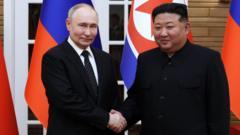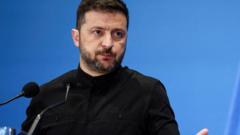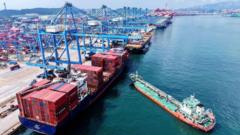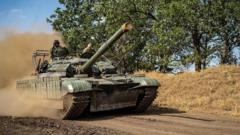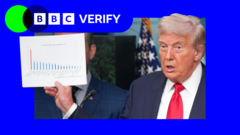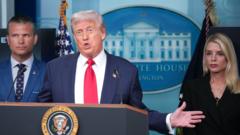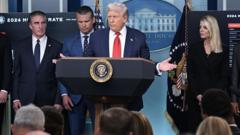As President Trump intensifies pressure on Russia through economic threats and planned meetings with President Putin, the Kremlin appears resolute in its military strategies, despite signs of economic strain. This article delves into the resilience of the Russian economy and the potential impact of Trump’s maneuvers.
Can Trump’s Economic Tactics Shift Russia's Military Agenda?

Can Trump’s Economic Tactics Shift Russia's Military Agenda?
An analysis on how President Trump's threats and diplomatic efforts may influence Russia amid ongoing conflicts.
In an escalating war of words and economic tactics, President Trump seeks to reshape Russia’s approach to its ongoing conflict in Ukraine. Recently, he announced a strategic meeting with President Vladimir Putin while simultaneously imposing economic tariffs on India for its continued purchases of Russian oil, a signal of his intent to cripple the financial underpinnings of Russia’s military efforts.
Early estimations indicated that Russia’s economy was stabilizing post-invasion, but current forecasts now paint a different picture. Growth rates have plummeted from a projected 4.7 percent in 2024 to a mere 1 to 2 percent this year, as the country faces dwindling oil revenues. The repercussions of international sanctions are evident, with stagnant civilian industries and rising inflation reflecting the economic tension within the nation.
Despite apparent hardships, the Kremlin’s economic team, often referred to as “firefighters,” is navigating these challenges carefully, maintaining military expenditure at around 8 percent of GDP while aiming to mitigate inflationary pressures. Such fiscal maneuvers have resulted in a paradox where the living standard for many Russians has reportedly reached its highest level in a decade, according to recent research.
However, is this balanced approach sustainable? Analysts caution that declining oil revenues — crucial for funding government expenses — could pose a significant challenge, raising suspicions about the Kremlin’s long-term war strategies. In light of these conditions, Trump’s threats, while strategically significant, may not yield the immediate results he hopes for.
Critics of the tariffs on India, Russia's second-largest oil purchaser next to China, argue that they might not alter India's course significantly, as Indian officials have reiterated their commitment to sourcing oil from Russia. Market adjustments indicate that discounts on Russian oil are already accommodating potential geopolitical fallout, underscoring the complexities of global oil interactions.
Analysts predict that while a drop in oil prices could exacerbate Russia’s budget deficit, it is unlikely to disrupt the Kremlin’s military plans. Trump’s bold assertions about the potential effectiveness of tariffs on energy prices have yet to translate into substantial shifts in Russian policy.
In summary, as President Trump leverages economic strategies to combat Russia’s military actions, the effectiveness of such measures remains uncertain, especially when set against the Kremlin’s resilient economic foundations and their military objectives.
This article, originally published in the New York Times, reveals the intricate dynamics at play between diplomacy and economic strategy amidst ongoing global conflicts.
Early estimations indicated that Russia’s economy was stabilizing post-invasion, but current forecasts now paint a different picture. Growth rates have plummeted from a projected 4.7 percent in 2024 to a mere 1 to 2 percent this year, as the country faces dwindling oil revenues. The repercussions of international sanctions are evident, with stagnant civilian industries and rising inflation reflecting the economic tension within the nation.
Despite apparent hardships, the Kremlin’s economic team, often referred to as “firefighters,” is navigating these challenges carefully, maintaining military expenditure at around 8 percent of GDP while aiming to mitigate inflationary pressures. Such fiscal maneuvers have resulted in a paradox where the living standard for many Russians has reportedly reached its highest level in a decade, according to recent research.
However, is this balanced approach sustainable? Analysts caution that declining oil revenues — crucial for funding government expenses — could pose a significant challenge, raising suspicions about the Kremlin’s long-term war strategies. In light of these conditions, Trump’s threats, while strategically significant, may not yield the immediate results he hopes for.
Critics of the tariffs on India, Russia's second-largest oil purchaser next to China, argue that they might not alter India's course significantly, as Indian officials have reiterated their commitment to sourcing oil from Russia. Market adjustments indicate that discounts on Russian oil are already accommodating potential geopolitical fallout, underscoring the complexities of global oil interactions.
Analysts predict that while a drop in oil prices could exacerbate Russia’s budget deficit, it is unlikely to disrupt the Kremlin’s military plans. Trump’s bold assertions about the potential effectiveness of tariffs on energy prices have yet to translate into substantial shifts in Russian policy.
In summary, as President Trump leverages economic strategies to combat Russia’s military actions, the effectiveness of such measures remains uncertain, especially when set against the Kremlin’s resilient economic foundations and their military objectives.
This article, originally published in the New York Times, reveals the intricate dynamics at play between diplomacy and economic strategy amidst ongoing global conflicts.


